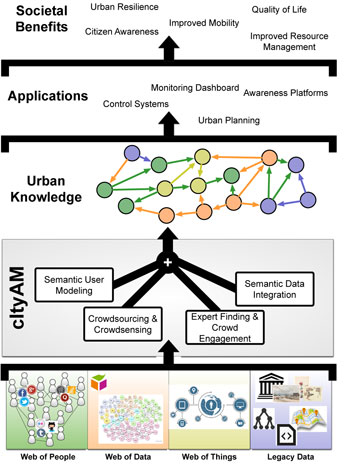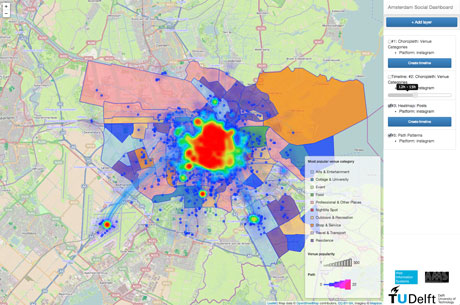by Alessandro Bozzon, Claudia Hauff and Geert-Jan Houben
As we race towards fully connected living environments at full speed, urban stakeholders and decision makers are demanding analytic solutions that are able to provide actionable insights about citizens and their interactions with these environments. The Web Information Systems group at Delft University ofTechnology responded to this challenge by developing cItyAM, an integrated platform that supports the analysis and modelling of urban data. This data is received from a wide range of sources including social media, (social) sensors, open government data and a multiple knowledge repositories.
An open and extendable urban analytics platform, cItyAM is designed to cope with big urban data, providing stakeholder and decision makers with a set of tools to 1) integrate and analyze various urban data types and 2) model, engage and interact with people in urban spaces.
In view of the trend toward making cities fully connected and rising urban population densities, cItyAM provide the wherewithal to exploit big urban data, thus allowing urban phenomena to be mapped (e.g., the mobility, environmental, sustainability and social aspects associated with urban lifestyles).
The cItyAM platform has been developed as part of a research initiative started by the Web Information Systems group at the Delft University of Technology in 2012. It was driven and inspired by several European- and national-level initiatives including the City Data Fusion EIT ICT Lab project (conducted in collaboration with Politecnico di Milano, CNR Pisa, SIEMENS, and Telecom Italia), the Amsterdam Institute for Advanced Metropolitan Solutions (AMS) initiative (which includes WAGENINGEN UR, MIT, TNO, and other societal and industrial partners), the SHINE project, the ImReal EU FP7 project, and the COMMIT SEALINCMedia project (conducted in collaboration with the VU Amsterdam, CWI, the Rijksmuseum, and others), as well as the experience gained from the spinoff activities around Twitcident. The goal of the cItyAM platform is to progress urban data management, by advancing our ability to “feel the pulse” of cities: it provides methodologies and systems for data fusion, analysis and visualization.

The cItyAM platform capitalizes on the experience of the Web Information System group and employs four main pillars:
1. Semantic user modelling techniques, drawn from the experiences gained during the ImReal project [1], and in this project tailored to the needs and features of urban citizen modelling. It allows for the semantically enriched analysis of conversations and activities which take place on social media channels (e.g., Twitter, Instagram and Foursquare).
2. Crowdsourcing and crowdsensing techniques for data collection, refinement and verification, integration and interpretation and processing. City-associated data can be patchy, noisy and disparate. Creating city related knowledge is driven by an extendable set of social sensing tools, like the CrowKnow system. Automatic techniques for data cleansing and linking often fail to achieve the levels of accuracy required for the effective fusion of urban data. Crowd-sourcing this cleansing and linking function is emerging as an effective means to solve the task when automatic methods fail.
3. Expert finding and crowd engagement strategies, developed within the COMMIT SEALINCMedia project [2] which actively drive the routing and engagement of citizens upon request from stakeholders. An example of this is when a crowdsensing campaign is initiated. The cItyAM incorporates incentive and engagement techniques that are specifically designed for urban environments and life styles.
4. Using the semantic data integration techniques that were also developed in the context of the ImReal project, cItyAM can interface with a broad range of data sources. The RDFGears framework [3] allows for the integration, publication and retrieval of data coming from physical sensors, crowds and existing knowledge repositories such as DBpedia and Freebase.

Selected components of the cItyAM platform have been deployed in the last two years to monitor and analyze city-scale events like the Milano Design Week, the Lucca Comics & Games, the Dutch King’s Day and others. In the future, we plan to deploy cItyAM as a continuous service operating in multiple cities around the world. In the context of Amsterdam, for instance, we plan to integrate with urban data sources managed by the municipality to support studies on urban mobility and social city life. In Rotterdam, the plan is to create social sensing solutions for water management, with a specific focus on emergency management for flooding events. Finally, we plan to provide a 24/7 social recommendation service covering the EXPO 2015 event in Milan.
Links:
http://citydatafusion.org
http://www.ams-amsterdam.com/
http://direct.tudelft.nl/shine-117.html
http://www.imreal-project.eu
http://www.commit-nl.nl
http://twitcident.com
http://www.wis.ewi.tudelft.nl/CroKnow
http://www.wis.ewi.tudelft.nl/research-lines/rdfgears
References:
[1] Qi Gao, et al.: “A Comparative Study of Users’ Microblogging Behavior on Sina Weibo and Twitter”, UMAP 2012
[2] J. Oosterman, et al.: “Crowd vs. experts: nichesourcing for knowledge intensive tasks in cultural heritage”, WWW (Companion Volume) 2014
[3] M. Grabowski, J. Hidders, J. Sroka: “Representing MapReduce, Optimisations in the Nested Relational Calculus”, BNCOD 2013
Please contact:
Alessandro Bozzon, Claudia Hauff, Geert-Jan Houben
TU Delft, The Netherlands
E-mail:











